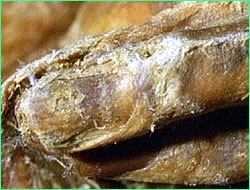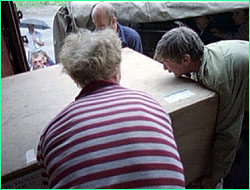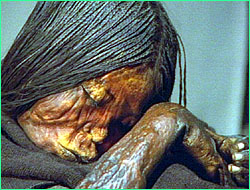 |

|

|
Unquiet Mummies
Part 2 (back to Part 1)
Knowledge at a Price
While opening fascinating windows into the past, such investigations of
mummies—from the initial opening of a grave site to display of remains in a
museum—often come at a price. It's a price that can leave one wondering
whether it might have been better to have left the mummy in the ground.
 Deteriorating flesh of Ice Maiden
Deteriorating flesh of Ice Maiden
|
| For one thing, to study an artifact is often to destroy it. Soon after the
Siberian Maiden was found, for example, her protective shroud of ancient ice
melted away and she began to decay. Preserved intact for two millennia, she was
now assaulted by airborne fungus and bacteria, dehydrated by low humidity, and
struck by the first sunlight she'd seen in thousands of years. A vampire would
fare better at such a rude daylight awakening. Within days it became apparent
to the Russian archeologists who had discovered her that the mummy was
degrading rapidly. They helicoptered her to Novosibirsk, but the unrefrigerated
delay, including almost a week of transport, took its toll. Even in the freezer
labs of Novosibirsk the mummy slept uncomfortably. Hardy fungus attacked
air-exposed skin and began to damage it. Desperate to stop the decay of their
prize, Russian scientists chose to inter her in the same kind of pickling vat
that preserved the bodies of Vladimir Lenin and Josef Stalin.
|  Transporting the Ice Maiden
Transporting the Ice Maiden
|
Decay can be far easier to control than the political or social controversy
that can arise over a mummy. The Siberian Ice Maiden's tomb was excavated by
Russian archaeologists, and its mummy and artifacts shipped to a Russian city.
But when the Union of Soviet Socialist Republics faltered, its former
member-states, including the Republic of Altay where the mummy was found, rose
up with demands for, among other things, restitution of stolen objects such as
the Siberian Ice Maiden. This was a thorny issue. The mummy had been taken for
the sake of science. But what are the criteria for scientific ownership? A
better lab? A more outspoken archeologist? Scientific clout? The people of the
Altay maintain a strong connection with their ancestors. How does science
balance with the respect due a people's heritage? What about this intangible:
the respect we all owe to the obvious solemnity with which the mummy's tribe
laid her to rest?
 Mummified child sacrifice
Mummified child sacrifice
|
|
Similar kinds of questions hold sway whenever a mummy is unearthed. Decay and
controversy attended the removal and study of the Iceman and Inca children as
well. The more recent the remains, the more controversial they are likely to
be. Witness the contentious debate in the United States over the bones of
Native Americans, both those uncovered in archeological sites and those already
housed in museums. Many people would argue that the dead, whether recent or
thousands of years old, should be left to rest in peace, undisturbed. But
others would argue just as strenuously against the loss of knowledge and
understanding of the past that would result in leaving such sites alone—sites that artifact-seeking graverobbers might destroy anyway. One thing is
clear: handling human remains is a tricky issue.
Jan Adkins is a writer, illustrator and designer who has produced
more than 30 books and many magazine articles on history, science and how things
work. He is a contributing editor for the Smithsonian/Cricket non-fiction
children's magazine, Muse.
Peru Expedition '96 |
Unquiet Mummies |
Iceman's Last Meal
Reading the Remains |
Resources |
Teacher's Guide
Transcripts |
Site Map |
Ice Mummies Home
Editor's Picks |
Previous Sites |
Join Us/E-mail |
TV/Web Schedule
About NOVA |
Teachers |
Site Map |
Shop |
Jobs |
Search |
To print
PBS Online |
NOVA Online |
WGBH
© | Updated November 2000
|
|
|



 Deteriorating flesh of Ice Maiden
Deteriorating flesh of Ice Maiden
 Transporting the Ice Maiden
Transporting the Ice Maiden
 Mummified child sacrifice
Mummified child sacrifice